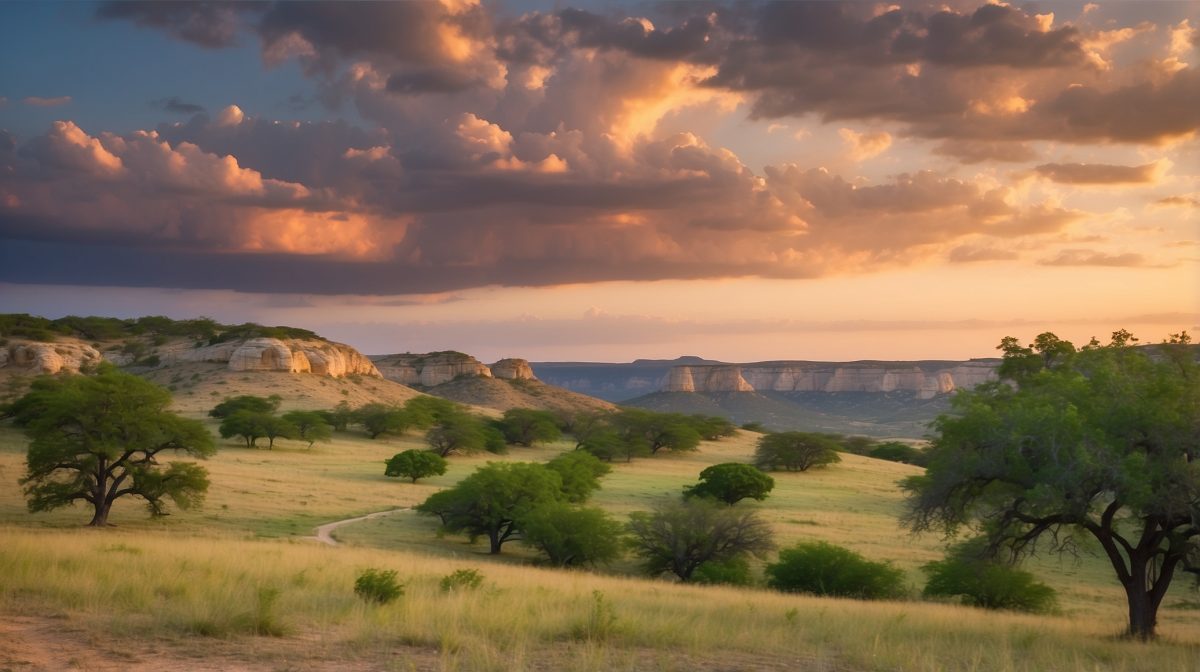Back in those days, the Hill Country was a tapestry of life and nature, with tales woven into every rolling hill and babbling brook. It’s a place where the past ain’t just remembered; it’s felt in the bones of the old homesteads and whispered by the winds through the live oaks. So sit a spell, and let’s mosey through the annals of history to see what the Hill Country was like in 1856.
The Geographic Landscape
Now, picture this: rolling hills as far as the eye can see, with rivers carving their way through like a master craftsman. The live oak trees stood guard, their branches stretching out like the welcoming arms of an old friend. It was a land where the bluebonnets and Indian paintbrushes painted the fields with a wild palette only Mother Nature could hold.
The critters here, from the white-tailed deer to the armadillos, were as much a part of the land as the soil itself. Folks worked the land, tending to their farms and ranches, under that big Texas sky. It was a hard life, sure, but it was honest work that connected man to the good earth beneath his feet.
People of the Hill Country
In 1856, the Hill Country was a melting pot of folks. You had your settlers, your Native Americans, and all sorts tryin’ to carve out a life in this rugged paradise. The German and Mexican influences were strong, adding a flavor to the community like a good spice does to barbecue.
Life was simple but full, with daily routines that followed the rising and setting of the sun. From the German beer gardens to the Mexican fiestas, each culture brought a piece of their heritage to create a community tapestry as colorful as a quilt from Fredericksburg.
Economy and Livelihoods
The bread and butter of the Hill Country economy back then were cattle ranching and farming. Cotton was king, and the land was dotted with farms as far as the eye could see. Barter and trade were the name of the game, with a handshake being as good as a contract, though the jingle of coins was startin’ to make its way into the mix.
The Hill Country wasn’t just a world unto itself; it was a vital piece of the Texas economy. From the cattle drives to the cotton gins, what happened here helped shape the wealth and future of the entire Lone Star State.
Architecture and Settlements
Back in those days, a homestead was more than just a place to hang your hat. Log cabins and limestone houses dotted the landscape, each one tellin’ a story of survival and hope. Towns and communities grew like wildflowers after a spring rain, with a layout that spoke of both practicality and the close-knit bonds of neighbors.
And wouldn’t you know it, some of those early landmarks are still standin’ today, silent sentinels of history that remind us of the roots we sprung from. They’re a testament to the grit and determination of those early Texans who built a life out of limestone and dreams.
Challenges and Triumphs
Life in the Hill Country in 1856 was as tough as a two-dollar steak. Settlers faced down disease, conflicts with the land’s original inhabitants, and weather that could turn on a dime. But like the mighty oak withstandin’ the storm, they showed a resilience that’s become the stuff of legend.
Triumphs were hard-won and celebrated with a joy that was as deep as the Texas roots. Key events, from battles to community gatherings, helped shape the Hill Country into the place of strength and character it is today.
The Hill Country’s Role in Texas History
The Hill Country played a pivotal role in Texas’ journey to statehood and its part in the Civil War. It was home to influential figures whose names are etched in the annals of history, leaders who helped steer the course of the state’s destiny.
Over the years, the Hill Country’s identity has evolved, but it’s always remained a cornerstone of what makes Texas, well, Texas. It’s a place where the past and present dance a two-step together, each step informing the next.
Conclusion
As we tip our hats to the bygone era of 1856, it’s clear that the spirit of those times still echoes through the Hill Country today. The history and heritage are as much a part of the land as the limestone and the live oaks. By understandin’ where we came from, we gain a deeper appreciation for the Hill Country we know and love today.
So whether you’re sippin’ a sweet tea on the porch or explorin’ the historic trails, remember that every piece of this land has a story, and those stories are the threads that weave the rich tapestry that is the Texas Hill Country.
FAQs
What were the main challenges settlers faced in the Hill Country in 1856?
Settlers grappled with diseases, skirmishes with Native Americans, and unpredictable weather patterns that could challenge even the heartiest of souls.
How did the various cultural influences shape the Hill Country community?
The German and Mexican cultures, among others, brought their traditions, architecture, and customs, creating a unique and vibrant community rich in diversity.
What role did the Hill Country play in Texas gaining statehood?
The Hill Country was instrumental in Texas’ journey to statehood, providing leaders and serving as a cultural and economic hub that supported the state’s development.
Are there any historic landmarks from 1856 that I can visit today?
Absolutely! There are numerous historic landmarks, from homesteads to town squares, that stand as proud monuments to the Hill Country’s storied past.
How has the economy of the Hill Country changed since 1856?
The economy has evolved from a focus on agriculture and ranching to include tourism, winemaking, and modern industries, while still honoring its roots.


